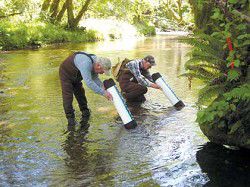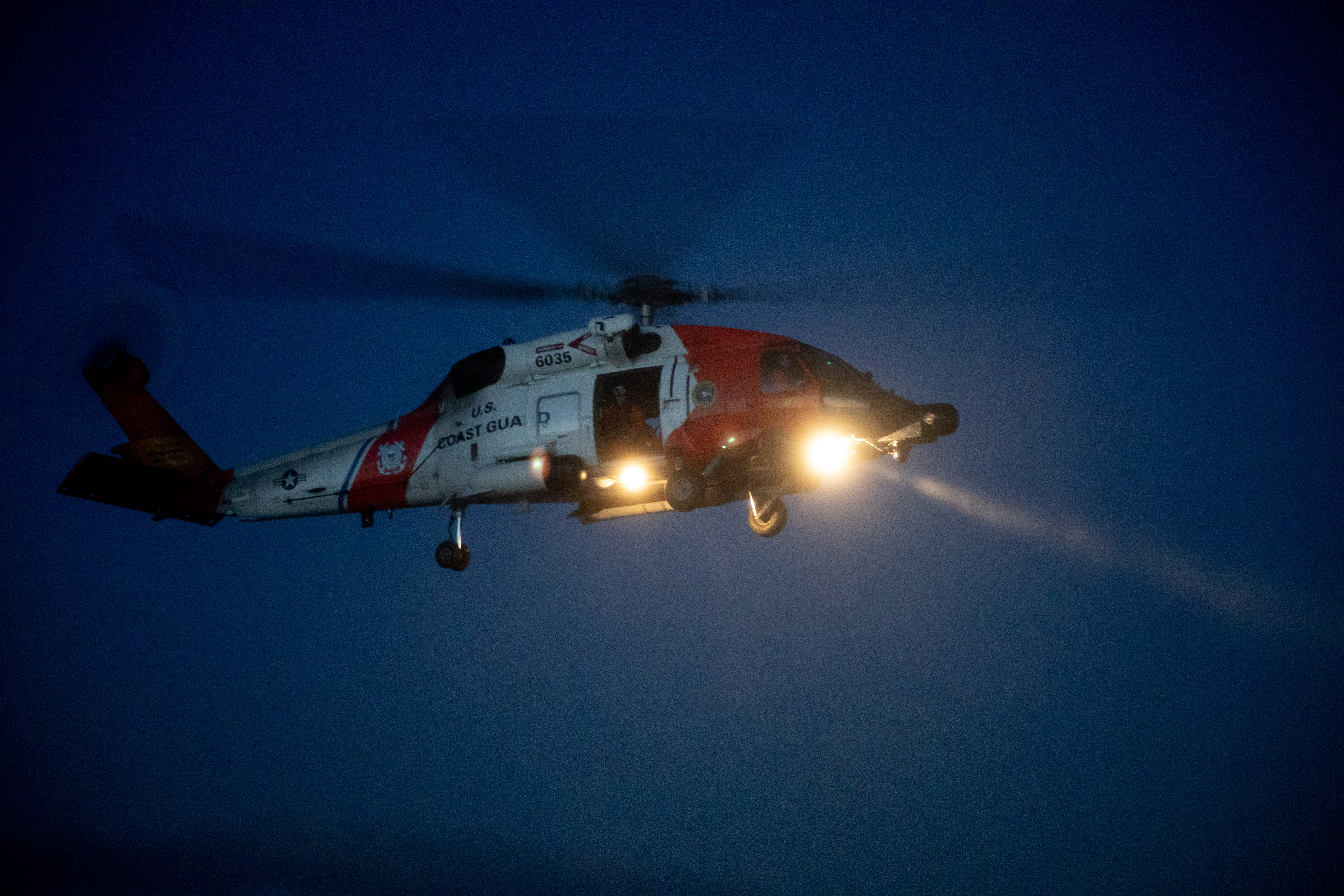Reintroducing mussel species to refuge creeks
Published 5:00 pm Tuesday, October 23, 2007

- <I>SUBMITTED photo</I><BR>Bill Hutton (left) and Russ Lewis search for western pearlshell mussels in a local creek using aquascopes.
WILLAPA REFUGE – Marie Fernandez reached down and carefully placed a western pearlshell mussel within the gravel substrate of the stream bed behind a protective piece of large woody debris. One down – 99 to go!
Trending
The Willapa National Wildlife Refuge has been busy the last few weeks transferring a freshwater mussel species, the western pearlshell, from a nearby river with a healthy population to three small streams on the refuge which contained no mussels. This landmark moment required a great deal of preparation and the cooperation of various entities.
In early September 2006, Willapa NWR Wildlife Biologist Marie Fernandez attended a meeting of the Pacific Northwest Native Freshwater Mussel Workgroup. Expounding on an idea that originated with Charlie Stenvall, project leader of the Willapa NWR Complex, she presented a pilot project to transfer freshwater mussels – specifically the western pearlshell (Margaritifera falcata) – to Willapa NWR streams.
The presentation highlighted previous successful efforts to reintroduce or enhance salmonid populations in various streams on the refuge and restore physical attributes of streams that have been severely impacted by historical land use in the past, including removing blocks to fish passage. Emphasized was the refuge’s desire to restore all native fauna to refuge streams where it is felt that previous detrimental land practices had impacted or extirpated healthy fish runs as well as had impacts on other stream dependent species, like the western pearlshell. The presence of salmonids is essential to the survival of western pearlshell mussels. Without the fish, mussels cannot reproduce.
Trending
Several weeks later in mid-October, two members of the Mussel Workgroup, Al Smith, chairman of the workgroup and Molly Hallock, freshwater native nongame fish biologist with the Washington Department of Fish and Wildlife, were able to come down to take a look at several of the refuge streams, a few of which were determined to contain suitable habitat. Suitable habitat for the western pearlshell consists of permanent streams with cool water temperatures, gravelly bottoms containing areas of stable substrate, medium gradients, clear water, and the presence of salmonid fish hosts, including cutthroat trout and coho salmon.
Fernandez made another presentation to the Mussel Workgroup in June with a collection, transfer and monitoring plan for the project which included descriptions of the habitat to be found in the transfer streams as well as details about fish populations.
Now came the hardest part. In order to transfer 100 western pearlshell mussels to the refuge, sufficient donor populations needed to be found. The Naselle and Bear Rivers were known to have populations of western pearlshell mussels, but would they have enough to allow taking a few for the refuge project? As far as refuge personnel and members of the Mussel Workgroup knew, no detailed data was available on populations of mussels in either of these rivers.
Enter intrepid refuge volunteers, Russ Lewis and Bill Hutton. Starting in early July along with Marie, Russ and Bill waded and snorkeled several miles of the Naselle and Bear Rivers looking for mussels. An essential item of equipment – the aquascope, a long thin tube with a clear bottom specifically built for underwater viewing. What do western pearshell mussels look like? Well, they look a lot like rocks! All visible mussels were counted and an attempt was made to break them into size categories based on the portion of burrowed mussel that was visible. (One stipulation for the surveys was that the mussels not be handled. Freshwater mussels are protected by law. According to current Washington law, “It is unlawful for any person to take or possess freshwater clams and mussels taken for personal use.”)
The most exciting survey day was a snorkel down a series of narrow canyons in the Upper Naselle River. Throughout the survey period the group enjoyed sightings of other river-dependent wildlife including otters, dippers, kingfishers and different age classes of salmonids. A rarely seen western toad was even spotted on the Naselle. In addition to surveying portions of the main stem of both rivers, special permission was granted by Longview Fibre to drive through a locked gate on the upper Bear River in order to survey a tributary, Spyder Creek.
By the end of August, more than 1,400 western pearlshell mussels had been visually surveyed on portions of the Bear River and more than 2,400 had been surveyed on portions of the Naselle. Armed with this hard-won data, applications for permits were submitted to WDFW. The refuge needed two permits for this project – a collection permit and a transfer permit. Expedited by Molly Hallock of WDFW, the refuge received the needed permits by mid-September. Due to having the most similar habitat, a decision was made to take the 100 mussels from Bear River. Assisted on one of the four transfer days by Brian Adair, a member of the Mussel Workgroup who had previously done similar mussel work in Tennessee, the group embarked on the final phase of the project.
Traveling to the largest mussel beds found on the Bear River, some of which involved quite a long walk, the group concentrated on proper collection, transport and relocation techniques in order to ensure best survival for the collected mussels.
The western pearlshells were carefully removed one by one from the substrate, noting their orientation and burial depth. All mussels were measured and weighed and a unique numbered tag was affixed to each valve of the shell. Photographs of each mussel were taken. Mussels were returned to a mesh bag in the river until all mussels that were to be taken from that particular bed were collected and processed. Mesh bags were placed in coolers filled with river water and transported back to the vehicle for the drive to the refuge. Placement considerations at the three target refuge streams included reduction of danger from siltation and utilizing stable sections of the streams, sometimes behind or along entrenched large woody debris and among tree roots to reduce the danger of high water, freshet events or debris dislodging mussels. Marie, Russ and Bill will be monitoring the mussels to see how they are doing in their new homes.
Everyone involved with the western pearlshell project has emerged with an appreciation and enthusiasm for these small creatures. Freshwater mussels are important components of aquatic systems throughout the world, but they are declining. Almost 300 species of freshwater mussels occurred in North America alone – there are only seven species native to the Pacific Northwest. Some states, especially in the southeast, contain over 100 different species. Some people must have had fun thinking of these colorful common names for a few North American species: Spectaclecase, Snuffbox, Washboard, Pistolgrip, Threehorn Wartyback, Round Pigtoe, Elephant Ear, Creeper, Creek Heelsplitter, Fat Mucket, Fawnsfoot, Fat Pocketbook and Lilliput!
Although not endangered or threatened, the seven species in the Pacific Northwest are in decline – their populations of concern to such groups as the Pacific Northwest Native Freshwater Mussel Workgroup. Overall in North America 75 percent are listed by individual states as threatened or endangered, 25 percent are federally threatened or endangered. It is too late for some species – over 35 have become extinct. In fact, freshwater mussels as a whole are considered the most endangered group of animals in North America. Troubles for mussels include poor water quality, the decline of native fish hosts, dams and channelization of rivers and the spread of exotic species in some areas, including the zebra mussel. Natural predators of freshwater mussels in our area include otters and raccoons.
The evolutionary strategy of mussels has involved the necessity of native fish hosts as an important part of their reproductive cycle. Mussels are not good travelers – they may move only a few yards from the place where they initially burrowed into the substrate. So how can they eventually populate many different and far flung sections of a stream or river? Why, they hitchhike! Mussel reproduction occurs generally in the spring. After fertilization, when the male releases sperm into the water and it is taken in by the female, several thousand eggs develop within specialized gills of the female called “marsupia” into tiny parasitic larvae called “glochidia.” The stage is set: now the female mussel need only wait. When the glochidia are ripe they may just be released into the water in certain mussel species. This is a crucial time – the glochidia must encounter the proper fish host and attach to the gills (or in some species, gills and fins). There they encyst and continue to develop for a period of up to several weeks after which they drop off to the substrate below. The baby mussel’s traveling days are now over and the fish taxi swims away.
Hopefully, with a lot of luck, the young mussel has arrived in an area of suitable habitat. Burrowing into the substrate, it will stay in this general vicinity for the rest of its life. Life for a young mussel is harsh. The chances of the glochidia encountering the proper fish host, successfully encysting, dropping off in suitable substrate and surviving to adulthood are extremely slim – odds are about one in a million.
Surprisingly, some mussel species have evolved rather elaborate ways of luring in a fish to increase the odds that some of their young will survive. Rather than just releasing glochidia into the water some mussels release a packet of glochidia called a conglutinate. Some conglutinates look like a small insect larvae, worm, or caterpillar (eyespots and all). What fish could resist? As the fish takes the “worm” in its mouth – the conglutinate explodes and before the fish can spit the surprise package out – it gets a mouthful of glochidia, which attach immediately to the fish’s gills. Other species send out a lure – a portion of the mussel’s mantle shaped like a small fish that even wiggles! Others send out a fishing line at the end of which sits a packet of glochidia ready to explode. C’mon fish – take a bite!
How old can a mussel be? Would you believe the western pearlshell can reach over 100 years of age? Because of their longevity, studying the shells of western pearlshell mussels is important to researchers as environmental changes in a stream or river have been recorded over time in their shells. These mussels are important indicators within the stream environment because they are highly sensitive to changes that affect water quality as well as streambed stability.
Generally less than five inches in length, western pearlshell mussels themselves help with water quality. Being filter feeders, they take in water through their incurrent siphon, straining it with their gills to remove oxygen as well as the plankton and organic detritus they feed on, then expelling it through the excurrent siphon thus helping to clean the water. This helps to “pay back” their salmonid hosts by creating better water conditions for egg health and survival of salmon and trout. Mussels also excrete “pseudofeces” and this nutrient rich substance settles to the bottom, consumed by a variety of bottom feeders, including aquatic invertebrates, important food items for salmonids.
If you are interested in learning more about our freshwater mussel species in the Pacific Northwest and Western North America check out the following Web sites:
? (www.fws.gov/columbiariver/musselwg.htm)
? (www.fws.gov/columbiariver/mwg/pdfdocs/Pacific_Northwest_Mussel_Guide.pdf)
? (www.biology.usgs.gov/status_trends/Shaul12APRIL06.pdf)









